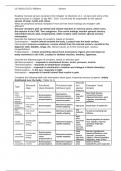Other
READING GUIDE: CHAPTER 14,16 OF HUMAN ANATOMY BIOD170 AT UCI
- Institution
- University Of California - Irvine
Reading guide for chapter 14 and 16 of Human Anatomy (9th Edition), by Marieb et al: "Senses". Used in the Applied Human Anatomy course at UC Irvine. Comes with bolded text answers and colored diagrams you can label.
[Show more]



